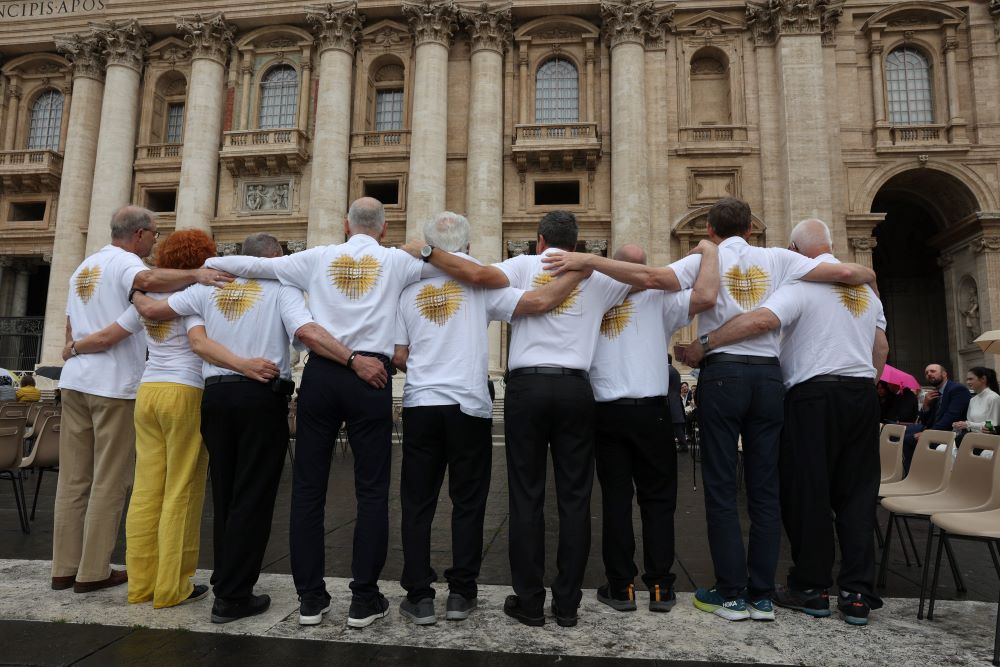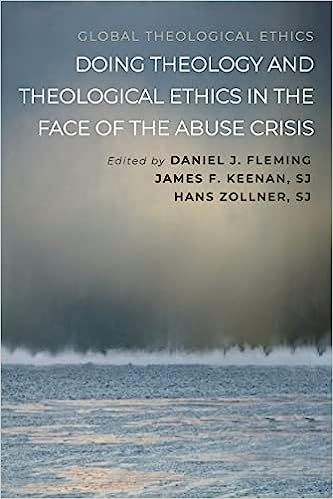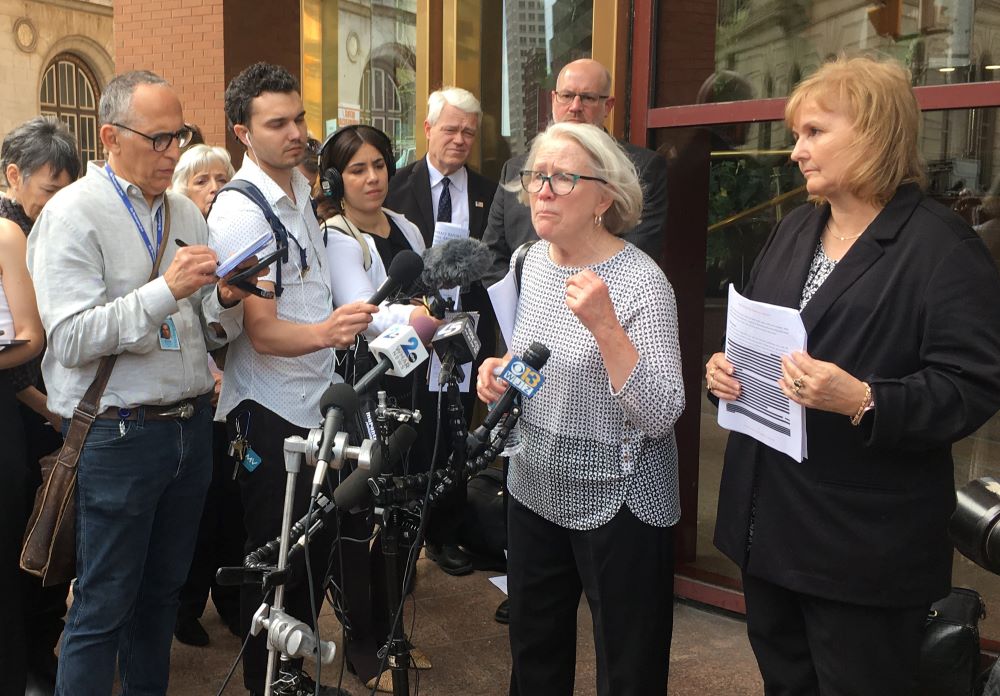
Eight men and one woman stand facing St. Peter's Basilica at the end of Pope Francis' weekly general audience in St. Peter's Square at the Vatican May 17. The group of survivors of sexual abuse by priests or religious bicycled from Munich to Rome to ask the pope to make the Catholic Church a safe space and to send a clear signal to perpetrators and bishops who avoid action. (CNS/Courtesy Archdiocese of Munich and Freising, Robert Kiderle)
The late great historian John O'Malley dated what he termed the Roman Catholic church’s "long nineteenth century" from the French Revolution in 1789 to the death of Pope Pius XII in 1958. Arguably, however, that counter-revolutionary, intensely clerical, ultramontane period in the church's life extended beyond Vatican II and met its final end only within the last 20 years, with the revelations of the scale and systemic nature of the church's sexual abuse crisis.
As John McGreevy remarks in his recent history of the church from the French Revolution to the present, while the bishops at the council changed much about the church, they did not "assess [its] structures," with the result that the "evolution toward transparency and shared governance" in many other institutions largely passed the church by. Until now. With report after report documenting violence, secrecy, silencing, complicity and complacency, a kind of transparency has come with a vengeance – though shared governance still lags.

The co-edited volume Doing Theology and Theological Ethics in the Face of the Abuse Crisis joins a growing body of literature seeking to both come to terms with the revelations and to envision a new, different future for the Catholic church, a future beyond what one contributor calls the scandal that "now clings to [it] with a dispiriting viscosity."
The book includes 22 chapters by authors from six continents, reflecting the volume's origins in a project of the network Catholic Theological Ethics in the World Church. As is to be expected with such a large number of chapters, there is some unevenness in quality as well as some repetition, but the volume succeeds not only in representing the global dimensions of the crisis, but also in indicating varied and distinctive local perspectives and concerns. For example, contributors from Nigeria focus on cultural challenges; contributors from Germany and Switzerland focus on ecclesiology.
It follows that the chapters and themes that stand out to readers also will vary, though there are commonalities across the continents. Power is a preoccupation of the volume: Michelle Becka, professor of Christian social ethics at the University of Würzburg, speaks to how it is distributed and whether it is controllable. German theologian Daniel Bogner states forthrightly that "the church is lacking sufficient mechanisms to place checks on power."
Bogner further asks, "Aren’t we all … dependent on mechanisms of formal and informal social control that prevent us from becoming perpetrators [of various kinds]?" And then he comments: "This is precisely where an organization that has a dysfunctional relationship with transparency, public criticism, accountability, and gender diversity is doomed to fail."
Not to be outdone, retired University of Oslo theology professor Werner Jeanrond adds that "the Roman Catholic system of exercising power is built on monarchic and paternalistic foundations. Today, a right use of such power can no longer be imagined or justified, most certainly not with reference to Jesus Christ and his proclamation of God’s praxis of love."
As those quotations suggest, this volume pulls no punches, for which the editors are to be commended. The contributors tend to be very favorable toward Pope Francis, and not so much toward Popes John Paul II and Benedict XVI, but even Francis' papacy is subject to criticism. In particular, Bogner and Australian theologian Neil Ormerod raise trenchant questions about the adequacy of Francis' emphasis on synodality in the face of what Bogner calls "the 'systemic' causes that have led to instances of sexual abuse within the Catholic Church."

Jean Wehner, a survivor of sexual abuse in the Archdiocese of Baltimore, addresses the media outside the Maryland Attorney General's office in Baltimore April 5. That day Attorney General Anthony Brown released a report on sexual abuse committed by representatives of the church, for the most part from the 1940s to the early 1990s, as well as the way the archdiocese responded to reports of abuse. (OSV News/Catholic Review/George P. Matysek Jr.)
According to Ormerod, "more is needed than … an episodic engagement of non-clerical perspectives." Bogner claims more fully that "[t]he current agenda of synodality does not address urgently needed steps for the development of constitutional frameworks" to replace "the monarchist constitutional framework that bears a substantial share of responsibility for sexual abuse within the Church."
Jeanrond, ecclesiology expert Richard Lennan and director of Catherine of Siena College at the University of Roehampton Tina Beattie all consider the traditional doctrine that, while members of the church can and certainly do sin, the church as such cannot, which seems to imply that no institutional vices can be ascribed to it. Jeanrond observes that, against that background, "official reactions to emerging accounts of abuse first displayed a rush to individualize abuse and to protect the institution against any attempt to identify systemic dimensions of clerical failure in the church."
Drawing from Karl Rahner, Lennan proposes that "[i]t is crucial … to make clear that all references to the church's holiness attest to the ineradicable presence of the Spirit as the church's source of life," thereby leaving open "the possibility that the ecclesial community will obscure rather than symbolize the gift of the Holy Spirit."
In an especially punchy chapter, Beattie outlines the "move from patriarchal to phallic theology" in the papacy of John Paul II, under the influence of what she memorably calls theologian and writer Hans Urs von Balthasar's "theo-pornographic fantasies" of Christ the bridegroom and his bride, the church. It's hard to imagine that "the gendered theologies that emerged during the papacy of John Paul II" didn't affect the handling of the abuse crisis, as it likewise emerged during that time. The Theology of the Body, for example, obscures reality more than illuminating it.
Several chapters examine the culture of clericalism, which Ormerod notes "combines elements of the aura of sacred power, a shared clerical life-style and patterns of formation, and [a] sense of group loyalty" that made it second nature to support and sometimes turn a blind eye to the misdeeds of "one of us."
Advertisement
In his chapter, Villanova University professor of theology and religious studies Massimo Faggioli does not disagree that the culture of clericalism furnished what Bogner calls "an opportunity structure for abuse and sexual violence," but Faggioli does caution that the crisis "is ecclesial and not just clerical." As he observes, "Abusers could rely on a web of protection much wider than only the hierarchical church." Notably, they often "could count on… silence and willful ignorance… among lay Catholics," which he claims the predominant "legal and journalistic narratives of the crisis tend to ignore."
Faggioli accordingly calls for a historiographical approach to the abuse crisis, on the grounds that "historical research imposes complexity, both in its method and in its interpretations," and might thereby contribute not only to a fuller understanding of the crisis, but also to its "de-politicization and de-ideologization."
It will be difficult to come away from this volume without feeling great sympathy for the many, many Catholics who, according to polls, have distanced themselves from the church in the aftermath of the abuse scandal. At the same time, the contributors show a heartening faith in the church — or at least a persistent hope that God is not yet done with it.
The urgency of the moment, however, cannot be overstated, and more than one contributor suggests that the church is now going through "the greatest ecclesial crisis since the Protestant Reformation." It seems unlikely that the clergy abuse truth and reconciliation committee that Kate Jackson-Meyer calls for will come to pass, but she is surely right that reconciliation is the order of the day. Jeanrond may also be right that "[t]he trust of the victims, of the survivors of abuse, and of the public can only ever be regained by a radically different way of being church."
Editor's note: Doing Theology and Theological Ethics in the Face of the Abuse Crisis is also available as a free online download here and here.








